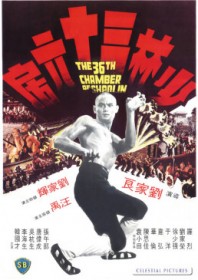
Lau Kar-leung’s famous kung fu film, based on monk San Te’s retribution (the Shaolin student credited for opening the temple’s gates to the secular world) plays like a standard revenge flick with some obligatory establishment-bashing thrown in for good measure. The key to the film’s legacy as one of the genre’s greatest treasures, then, lies in its insightful and earnest depiction of the Shaolin Temple as not only a vessel for superhuman kung fu training, but also as a place of solace, piety and emotional development. Here, Lau portrays the spiritual birthplace of martial arts as a character in the narrative, one which encompasses the heart of the film.
San Te learns how to head-butt sandbags, float on water, and even invents his own trademark weapon (the three-sectioned staff), yet his years of martial arts training and Buddhist learning bares no real impact on his bloodthirsty quest for revenge. Lo Lieh plays the evil tyrant (now there’s a surprise) who slays countless rebels and innocent people, including San Te’s family and friends. The real juice is in the middle, where Gordon Liu steps out of his shell to reveal a naïve charm and intensity that would help to form the start of an iconic career for the Shaw Brothers star. In genre terms, the film’s influence has been profound; particularly in the USA, where its popularity grew out of the grindhouses and onto the streets, and the repercussions could be felt through hip-hop and later mainstream cinema, most notably by Quentin Tarantino in his Kill Bill films.
AKA: Disciples of Master Killer; Master Killer; Shaolin Master Killer; The Thirty-Sixth Chamber.
- Country: Hong Kong
- Action Director: Lau Kar-leung, Wilson Tong Wai-shing
- Directed by: Lau Kar-leung
- Starring: Frankie Wai Wang, Gordon Liu Chia-hui, Henry Yu Yeung, Kok Lee-yan, Lau Kar-wing, Lee Hoi-san, Lo Lieh, Wilson Tong Wai-shing, Wong Yu
- Produced by: Run Run Shaw
- Written by: Eric Tsang Chi-wai, Ni Kuang
- Studio: Shaw Brothers












